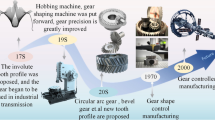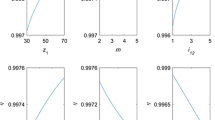Conclusion
This mathematical model of an ideal planetary pin (roller-tooth) reduction gear can be used to calculate at the planning stage how the dynamic transmission parameters are affected by meshing rigidity along the satellite profile, by deformation of the satellite under applied forces, by the presence and the nonuniformity of gaps in the meshing, and by manufacturing tolerances in the transmission. Calculations of a non-ideal transmission indicate that the transmission loads are affected significantly by manufacturing tolerances: the acting forces grow by a factor of 2.4 and the contact stresses grow by 65%, as compared to an ideal transmission. Also, universal recommendations were obtained on the optimum meshing parameters: m =0.5–0.9 and q=(0.5–0.6)ρmin.
These results allow a more accurate and substantiated solution to the design of planetary pin reduction gears with epicycloidal meshing.
Similar content being viewed by others
References
O. V. Berestnev and N. G. Yankevich, “Loads on trochoidal transmission elements,” Vestnik. Mashinostr., No. 3, 37–40 (1990).
V. N. Kudryavtsev, Planetary Transmissions [in Russian], Mashgiz, Moscow-Leningrad (1966).
V. K. Lobastov, “Stress distributions in the pin meshing of a planetary-pin reduction gear,” Izv. Vuz. Mashinostr., No. 7, 23–28 (1970).
G. S. Pisarenko, A. P. Yakovlev, and V. V. Matveev, Strength of Materials Handbook [in Russian], Naukova Dumka, Kiev (1988).
N. G. Yankevich, “Loading and quality assurance of trochoidal transmission elements,” Dissertation for Candidate of Technical Sciences [in Russian], Minsk (1990).
J. G. Blanche and D. C. H. Yang, “Cycloid drives with machining tolerances,” J. Mechanisms, Transmissions and Automation in Design Trans. ASME,111, 337–344 (1989).
R. Baren, “Improvement relating to cycloidal gears,” British Patent Specification No 1,516,959.
S. K. Malhotra and M. A. Parameswaran, “Analysis of a cycloid speed reducer,” Mech. Machine Theory,18, No. 6, 491–499 (1983).
Yu. K. Taldenko, “Effect of the pitch factor of an epicycloid on the basic characteristics of epicycloidal gear engagement,” Khim. Neft. Mashinostr., No. 11, 25–26 (1993).
Additional information
Translated from Khimicheskoe i Neftyanoe Mashinostroenie, No. 4, pp. 1–6, April, 1994.
Rights and permissions
About this article
Cite this article
Taldenko, Y.K. Mathematical model of planetary roller-tooth reduction gears. Chem Petrol Eng 30, 145–153 (1994). https://doi.org/10.1007/BF01149777
Issue Date:
DOI: https://doi.org/10.1007/BF01149777




